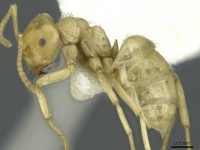Lasius mikir
| Lasius mikir | |
|---|---|

| |
| Scientific classification | |
| Kingdom: | Animalia |
| Phylum: | Arthropoda |
| Class: | Insecta |
| Order: | Hymenoptera |
| Family: | Formicidae |
| Subfamily: | Formicinae |
| Tribe: | Lasiini |
| Genus: | Lasius |
| Section: | flavus clade |
| Species group: | umbratus |
| Species: | L. mikir |
| Binomial name | |
| Lasius mikir Collingwood, 1982 | |
The discovery of mikir in Assam is of great interest as it is a definite record of a Lasius species inhabiting a tropical environment. Unfortunately, no information is available about the particular habitat in which the specimens were collected but, as the related species L. crinitus is often found inhabiting leaf litter in the alpine Himalayan zone, mikir may also be a specialized litter inhabitant (Collingwood 1982).
Identification
Collingwood (1982): A southern species related to crinitus but with reduced and more adpressed body pilosity, clearer body colour and more parallel-sided head. L. mikir is clearly related to crinitus in body size, pilosity and scale shape but is distinguishable by the much less abundant pilosity on the head and coxae, the paler colour and shape of the scale.
Keys including this Species
Distribution
Distribution based on Regional Taxon Lists
Oriental Region: India (type locality).
Distribution based on AntMaps
Distribution based on AntWeb specimens
Check data from AntWeb
Countries Occupied
| Number of countries occupied by this species based on AntWiki Regional Taxon Lists. In general, fewer countries occupied indicates a narrower range, while more countries indicates a more widespread species. |

|
Estimated Abundance
| Relative abundance based on number of AntMaps records per species (this species within the purple bar). Fewer records (to the left) indicates a less abundant/encountered species while more records (to the right) indicates more abundant/encountered species. |

|
Biology
Castes
Nomenclature
The following information is derived from Barry Bolton's Online Catalogue of the Ants of the World.
- mikir. Lasius mikir Collingwood, 1982: 295, figs. 10, 23 (w.) INDIA.
Description
Worker
Head robust with subparallel sides and feebly emarginate occipital border. Eyes. relatively large: their maximum diameter about twice the maximum scape width. A smooth trace of frontal furrow. Antennae elongated. Mesosomal dorsum slightly higher than the propodeum in side view. Petiole thin, with plane and superiorly converging anterior and posterior faces. Scale in frontal view with almost straight, converging sides and a pointed, non-emarginate apex. Frontal area and tarsi inflated.
Body colour moderately shining and entirely pale yellow, much paler than in any other known Himalayan species. Anterior clypeal border and mandibles brown. Integument smoothly punctate and very finely reticulate. The whole body is covered by fine, silky and adpressed pubescence. Antennae and legs entirely destitute of standing hairs. Some sparse whitish subdecumbent hairs on the frons, in number never exceeding 6-7 on the full cephalic profile. Analogous hairs (but often longer, suberect and curved) visible on the dorsal outline of the alitrunk and concentrated on the median areas of the pronotum, mesonotum and propodeum. 4-6 standing straight hairs on the external border of the scale. Gaster sparsely covered with adpressed straight hairs partly arranged in files at the border of every tergite.
Measurements: Total length 3.9 4.6 mm. EL 0.17-0.21 mm; EW 0.13-0.16 mm; HL 1.17-1.30 mm; HW 1.09-1.22 mm; SL 1.01-1.12 mm; OI 62.50-85.71; CI 91.30-94.00; SI 91.49-97.62.
References
- Collingwood, C. A. 1982. Himalayan ants of the genus Lasius (Hymenoptera: Formicidae). Syst. Entomol. 7: 283-296 (page 295, figs. 10, 23 worker described)

